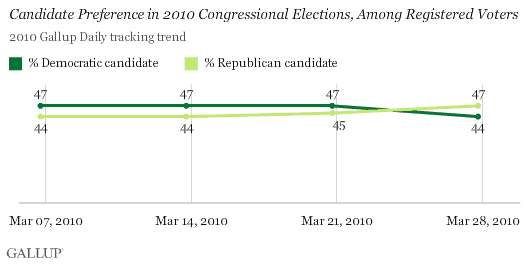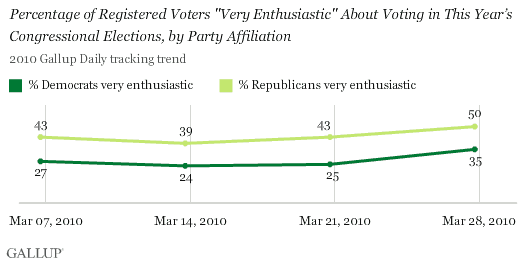PRINCETON, NJ -- Registered voters now say they prefer the Republican to the Democratic candidate in their district by 47% to 44% in the midterm congressional elections, the first time the GOP has led in 2010 election preferences since Gallup began weekly tracking of these in March.

The March 22-28 results were obtained after the U.S. House's passage of landmark healthcare reform legislation on March 21. The shift toward Republicans raises the possibility that the healthcare bill had a slightly negative impact on the Democrats' political fortunes in the short run.
A separate USA Today/Gallup poll conducted March 26-28 showed a similar result, with Republicans ahead by 46% to 45%.
These results suggest the Republicans would have a strong showing if the midterm elections were held today. Since Republicans usually vote at higher rates than Democrats, the Republicans' edge in voter preferences would likely exceed what the registered voter results indicate.
A Republican advantage among all registered voters in midterm elections has been rare in Gallup's 60-year history of tracking congressional voting preferences, happening only a few times each in the 1950, 1994, and 2002 election cycles -- all years in which Republicans had strong Election Day showings.
Voters More Enthusiastic
Supporters of both parties are more energized about voting than they were before the healthcare bill passed. Fifty percent of Republicans and 35% of Democrats say they are very enthusiastic about voting this fall, up from the prior week's 43% and 25%, respectively.

Among all registered voters, the increase in the percentage very enthusiastic about voting was eight percentage points from last week, 32% to 40%.
The USA Today/Gallup poll also shows a spike in voter enthusiasm in response to a different question, as now 62% of voters say they are "more enthusiastic about voting than usual," up from 47% in early February. That is higher than Gallup has measured at any point in any of the past four midterm elections. The previous high of 49% was measured during the 2006 campaign.
Supporters of both parties show similar gains on this enthusiasm measure, with a 14-point increase among Republicans (including Republican-leaning independents) and a 16-point increase among Democrats (including Democratic-leaning independents). As a result, Republicans remain more likely to say they are more enthusiastic about voting this year, by 69% to 57%.
Over the past four midterm elections, the party with the net advantage in enthusiasm has typically been the one to gain congressional seats in the election.
Survey Methods
Results are based on telephone interviews with a random sample of 1,623 U.S. registered voters, aged 18 and older, conducted March 22-28, 2010. For results based on the total sample of national adults, one can say with 95% confidence that the maximum margin of sampling error is ±3 percentage points.
Interviews are conducted with respondents on land-line telephones (for respondents with a land-line telephone) and cellular phones (for respondents who are cell-phone only).
In addition to sampling error, question wording and practical difficulties in conducting surveys can introduce error or bias into the findings of public opinion polls.
